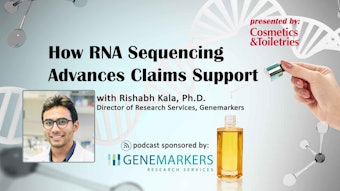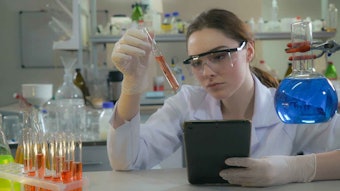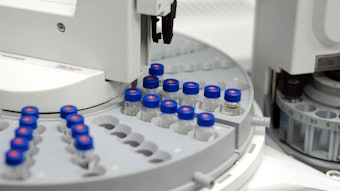It happened again—this time at the Skin Forum in Edinburgh, Scotland. This conference showcased different types of research involving skin but once again, as in many previous conferences, a toxicologist explained to the audience how to perform tests without adhering to scientific rules. Do the laws of science not apply?
The audience listened as an estimate was made for the concentration of a material penetrating the skin. This was calculated by multiplying the applied dose by the percentage of skin penetration, then dividing this result by the application area to calculate the local skin concentration. This compared to a level having no adverse effects, and from this, an estimate of the toxicological impact was made. Sounds okay, right? Think again!
People often forget is that it is wrong to express skin penetration in percentages. The toxicologist presenting gave an example of a metal (such as nickel), and asked the audience what the typical penetration would be: 100%, 10%, 1% or 0.1%. No one said anything. The presenter explained that normally his audience would respond 1%, and he subsequently showed that even skin penetration at only 0.1% was sufficient to kill the imaginary subject on the Powerpoint slide. He also used too large a number for the surface area of hands. Typically, the subjects used to make these calculations are thinner, thus leading to higher estimates than would be found in the body of more average subjects. This, too, sounds okay, right? Think again!
When the presentation was over, this author asked the presenter why toxicologists always express skin penetration in percentages and not in microgram per square centimeter per hour, as is done by skin delivery scientists. He answered, "Because we do."
The night before this conference, the Dutch national football team (soccer, for Americans) had defeated Uruguay in an exciting match in South Africa, winning the semi-finals. Had the match lasted 5 min longer, the Uruguayans may have won. Like many sports fans, the Dutch have a habit of painting their faces orange (and houses and cars, if their wives allow them) to contribute to a nationalist feeling especially since, for the first time since 1978, the Dutch are in the finals of the World Cup. (We lost the finals in 1974 against the Germans, and again in 1978 against the Argentineans). So, since the Dutch football team has made it to the finals again, 32 years later, some people would jump into a swimming pool of orange paint if they had one.
Now imagine a toxicologist standing at the edge of this swimming pool, stating “Sir, I do not think it is wise to jump into this pool. I have performed my calculations and I can assure you that it is dangerous to jump into this swimming pool filled with orange paint." If the skin penetration of the paint was 0.1%, the swimmer would absorb 10 kg of orange paint into his skin and be orange for the rest of his life.
Taking this theoretical but admittedly ridiculous example one level further, say the match between Spain and The Netherlands was the best match of the entire tournament, since the Dutch were playing to win and the Spaniards were playing their brilliant minimalist football again. Arjen Robben scored the first goal in the 14th minute, David Villa the second in the 40th, Carles Puyol the third in the 75th, and Wesley Sneijder the fourth in the 80th. In the 92nd minute, Dirk Kuyt makes the last goal of the tournament, bringing the score to 3-2 for the Netherlands. Two minutes later, the referee ends the World Cup Championship in South Africa by blowing his whistle. Although David Villa wins the award for the best player of the tournament, the jubilant Dutch national team brings home its very first World Cup Championship.
Following this triumph, on the afternoon of Tuesday, July 13, 2010, some Dutch fans decide to add orange color to the canals of Amsterdam where the Dutch national football team is being cheered on by millions of fans while they sail the canals of Amsterdam. Like 1988 when the Dutch won the European Championships, quite a few people ended up in the now orange water of the canals of Amsterdam.
Amidst the cheering, one could hear the toxicologist say, "Sirs, I do not think it is wise to jump into this orange-colored canal. I have done my calculations and I can assure you that it is dangerous to jump into this orange-colored canal. Even if the skin penetration was as low as 0.01%, you would absorb 100 kg of orange paint into your skin and would be painted orange for eternity.” But this news is simply ignored in the classical Dutch way, where rules only exist to be broken. The 16 million Dutch football supporters did not mind being orange for eternity, and even the latest Dutch immigrant jumped into the orange canals to show his/her commitment to the country.
The alternative scenario is that the Dutch would color the oceans orange to take revenge on the otherwise sympathetic and friendly Spaniards. In this case, skin penetration remains at 0.001% but with more than one million people alone in The Netherlands wanting to drown themselves in the ocean rather than waiting another 32 years to play another final, no orange dye would even be left to color the water. After all, 1,000,000 X 0.001% = 1,000%, which is 10X more than all the orange dye the Dutch used in the first place.
Circling back to the conference, this author's point is that toxicologists of the world should see that skin penetration is expressed as micrograms per square centimeter per hour and nothing more. Dose and percentages are irrelevant. If cosmetic scientists calculated like toxicologists, they would dose a kilogram on the skin and the percentage of penetration would always be low. Does a higher dose make a chemical more safe? Does an orange football make a Dutch football player more deadly? Sound okay? Think again!
Oftentimes at conferences, toxicologists tell this author that they measure skin penetration in percentages because, “The regulators force us to do it this way!” Of course, only the material in the immediate proximity of the skin will penetrate, but this is how the cosmetic industry plays its game. The Fédération Internationale de Football Association (FIFA) continues to ban videos from being used in controversial situations on the football pitch but FIFA always wins, even if it is wrong. The toxicologists always win, even if they are wrong. The Spaniards always win, even if they…. or maybe?
The future may not be as black as it looks. In fact, it is this author's hope that the world will see on Sunday that the future is orange. To all my Dutch and Spanish friends, may the best (orange) team win…










